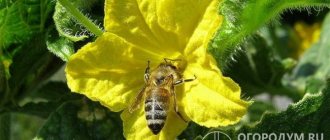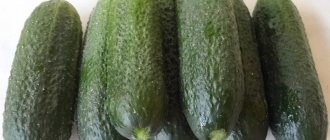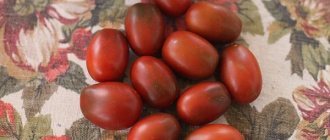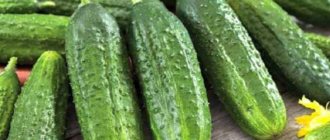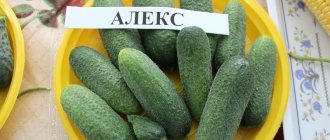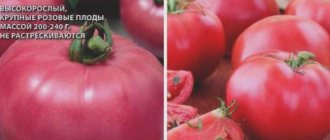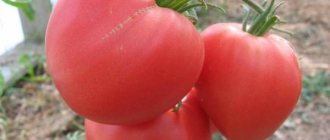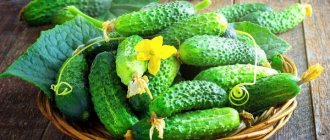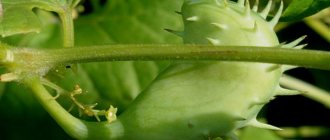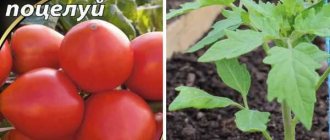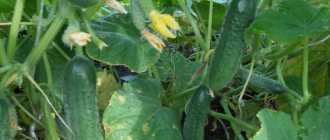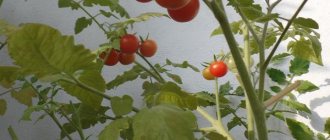Moravian gherkin is one of the best types of cucumber for pickling and pickling. This is a hybrid of two different varieties - Primadonna and Filippok F1. Brought out in the late 80s by the Mironovsky Research Institute of Breeding and Vegetable Growing. Suitable for cultivation in all regions, although most of all it loves fertile chernozem soils. It ripens much earlier than other varieties with proper care and timely planting in open ground. The peculiarity of the Moravian species is its high yield when cultivated exclusively in open ground.
Description and characteristics of the variety
Moravian gherkin F1 is suitable for growing in open beds and protected areas. It is a hybrid in which insects participate in pollination. The first fruits ripen early.
Features of the bushes:
- strong central trunks;
- moderate side whips;
- tall bushes;
- average foliage and climbing.
Harvesting begins 47-50 days after germination. It is advisable to harvest once every 2 days or daily. The hybrid belongs to the mid-early species.
Fruit signs:
- length 6-8 cm;
- weight 60-70 g;
- diameter 2-3 cm;
- spindle-shaped;
- sparse tubercles;
- pubescence is white;
- the pulp is juicy, but not watery;
- elastic consistency;
- The taste is classic without acid or bitterness.
The gherkins are used for mass canning and look great in jars. They are tasty and healthy in fresh form - slices, snacks, salads.
Basic indicators
Moravian gherkin is a high-yielding variety. 7-7.5 kg of fresh gherkins are harvested from one bush per season, and up to 16 kg from one m2. Among gherkins, this yield indicator is very high. With their early ripening and high yield, Moravian cucumbers can safely be considered one of the best. To obtain such an amount of harvest, it is necessary to provide the hybrid with the standard growing conditions it needs.
Advantages of Moravian fruits compared to other types of gherkins:
- Taste. No bitterness even after long-term storage.
- Undemanding to growing conditions.
- Resistance to the main cucumber disease - powdery mildew and the tobacco mosaic virus.
- Health benefits of fruits. It is the Moravian gherkin that is rich in vitamins, potassium, calcium, phosphorus and iodine. With regular consumption of these cucumbers, the functioning of the cardiovascular and digestive systems of the body is normalized. The quality of the thyroid gland also improves.
Note!
There are no disadvantages, other than the need for careful feeding.
Moravian gherkin is a bee-pollinated variety. Because of this characteristic, it is suitable for growing only in open beds; in a greenhouse, the pollination process is difficult. The best varieties for pollinating the Moravian gherkin:
- Be healthy F1;
- Okhotny Ryad F1;
- Hit of the F1 season;
- Saltan F1;
- Cheetah
If they are planted nearby, then the bees pollinate it more easily and efficiently.
Landing
Cultivation is carried out using seedlings and non-seedlings. Seeds are sown in open beds in the last 5-6 days of May, the first 2 weeks of June in temperate latitudes. The air temperature should be
- 18-20 degrees
- and the soil - not lower than 12 degrees.
For seedlings, seed material is planted in a nutrient substrate a month before transplanting into stationary beds. The containers used are large peat cups (at least 0.3 l), cassettes with sides up to 10 cm.
The following conditions are maintained for seedlings:
- the temperature before germination under the film is 25-27 degrees, after germination the temperature is within 20-22 degrees;
- humidity at 75-85%;
- feeding, starting from the stage of appearance of the 1st leaf;
- moderate irrigation through a spray bottle.
The bushes are transplanted at the age of 25-30 days, when they grow 4 leaves. The depth of the hole is selected according to the size of the cup. From fertilizers, add a handful of compost and 25 g of superphosphate, 10 g of potassium sulfate. The soil is carefully compacted, pouring it down to the first leaves.
Optimal distance
- between ridges 60-70 cm
- in lines of 30-35 cm.
Description and characteristics
The plant type is indeterminate. It assumes tall bushes - more than 60-70 cm. It reaches this length a month after planting in open ground and gradually stops developing. Due to its high growth, a garter is required to help avoid breaking the stem.
Note! The bushes are dark green in color, with soft fluff along the stem and leaves. Color – deep green. The stem thickness is standard - 1-1.5 cm.
The bushes are lush, a lot of shoots and ovaries are formed, but they are considered medium-climbing. The branches are short, but located close to each other, due to which the effect of splendor is created. The Moravian gherkin has only female flowers. When flowering they are yellow, sometimes with white streaks at the base.
Basic recommendations for growing
Even a novice gardener knows that a cucumber is 95% water. Taking this into account, it is necessary to carry out care:
- abundant watering - 1 plant should require approximately 0.5 liters of water per day;
- timely fertilizing with nitrogen and potassium fertilizers - these can be either specialized preparations or prepared independently;
- weeding as long as it can be done between plants, i.e. until the bushes become heavily overgrown.
You can tie the bushes to special trellises or mesh or leave them to trail along the ground. In both cases, the harvest will be good, it’s just that when tying the cucumbers, it’s much more convenient to pick and care for them much easier.
The best way to feed cucumbers of this variety is a solution of manure.
It is prepared like this:
- Take 1 liter of manure and dilute it in 10 liters of water.
- The mixture is infused for 12 hours and then the bushes are watered with this solution.
See also
Reasons why cucumbers may be bitter and what to do
Read
Thanks to this feeding, the ovaries become strong, produce a good harvest, and do not get sick.
Cucumbers grow quite quickly, so the first fruits appear 50 days after germination. In order to enjoy gherkins, you need to harvest them daily, not allowing the cucumbers to outgrow. But for those who like older fruits, you can pick them every other day.
Resistance to diseases and pests
The main diseases of cucumbers - powdery mildew and tobacco mosaic - do not threaten the gherkin. However, there is a list of diseases and pests for which preventive treatment is necessary:
- Rust. Brown spots first appear on the shoots of the plant, later they spread to flowers and developing fruits. Fungicidal preparations are suitable for control.
- Aphid. The first appearance most often goes unnoticed. As the disease develops, the leaves gradually curl, dry out and fall off. If the appearance of aphids coincides with the flowering period, then the flowers also fall off. Young cucumbers are also susceptible to yellowing, rotting and falling off if treatment is not started in time.
- Spider mite. It is expressed in the change in color of green leaves to yellow, later they dry out and fall off. To combat spider mites, preventive digging and watering with insecticidal preparations are carried out.
- Root-knot nematode. Slows down plant growth and causes failure of the root system. To combat it, hot air treatment is required.
Features of agricultural technology of the variety
To plant a hybrid, you do not need to prepare seedlings in advance. It is enough to plant the seeds immediately in open ground. Although the seedling method is also used. It is necessary to plant seeds in well-warmed soil, so it is recommended to wait until the end of May.
Planting seeds:
- A maximum of five bushes can be planted on one m2.
- The planting depth is 1.5-2 cm.
- A few hours before planting, carefully dig up and plow the soil.
- For additional aeration, add dry leaves and sawdust to the soil.
- 3-4 days before planting, add humus or manure to the ground. This way the soil will have time to be saturated with useful microelements, so that it can then be given to the growing plant.
- When planting seeds in the soil, it is not recommended to water them immediately; you need to wait a little - for two to three days.
- It is also better not to fertilize the soil at the moment of planting. In general, it is better to touch seedlings as little as possible.
Seedlings are prepared in a separate way:
May be interesting Cucumbers “Emerald earrings f1”: rules for planting, growing and careCucumber leaves turn yellow in a greenhouse, causes and methods of controlFeatures of growing the hybrid cucumber “Magnat f1”
- Seeds are planted in a pre-prepared pot 30-35 days before planting in open ground.
- The soil temperature at planting should be 23-25 oC. You need to regulate the temperature using film: cover the seedlings immediately after planting and open them only for watering and fertilizing. After the first shoots appear, the film is removed and the temperature drops.
- The soil in seedlings also needs to be loosened sometimes. The main thing is to do this carefully, without damaging the thin, not yet fully formed roots.
- Preparing the soil for planting is carried out in the same way as for planting seeds.
The Moravian gherkin has its own growing characteristics that must be observed.
For good growth and harvest it is necessary to organize proper care. List of actions:
- As weeds appear, the beds are weeded for better aeration.
- Simultaneously with weeding, the soil is loosened for a similar purpose.
- Feed the cucumbers twice a month. It is best to prepare fertilizer from water and manure. The ratio of components is 1:10. It is optimal to fertilize directly at the root and only in the evening.
- Harvesting must be done once a day. It's best to do this in the morning. At this moment, the cucumbers are the juiciest and hardest.
To stimulate the continuous growth of the bush, watering the plant is allowed twice a day.
Note!
Mulching is another important step in caring for cucumbers. Sawdust is used for this.
It is also recommended to tie cucumbers as the vegetable grows. This is done in order to avoid stem breakage.
Description and main characteristics
Hybrid Moravian gherkin is a classic pimply small cucumber. The peculiarity of such hybrids is their short length (just right for salting and pickling), dense crispy flesh, and pleasant taste.
The originator is the company MORAVOSEED` SPOLECNOST S RUCENIM OMEZENYM (Czech Republic), since 1998 the Moravian gherkin has been registered in the State Register of the Russian Federation. The catalog states that the plant is recommended for cultivation in two regions of the country:
- Middle Volga;
- Nizhnevolzhsky.
As reviews from summer residents show, the planting area of the hybrid is extensive and is not limited to two regions. The variety is cultivated in summer cottages and in small farms for sale.
On a note! Gherkin-type cucumber varieties are a special group in which the greens at the stage of full biological maturity are small in size.
The plant is powerful, with unlimited length, reaching 1.5-1.8 meters (indeterminate type). Leaf blades with a slight wave and slight wrinkles, light green color.
Characteristics of greenies:
- fusiform;
- color – bright green;
- length – 7-8 cm;
- weight – 68-80 g;
- the tuberosity is small;
- pubescence whitish;
- the flesh is dense, with a crunch;
- pleasant, slightly sweet taste.
Zelentsy earned high marks from professional tasters, but most importantly, summer residents liked the cucumbers. Use – various preparations, marinades, pickles, preservation. Gherkins are also used for cutting, decorating dishes, and fresh in salads.
The cucumber begins to bear fruit early, after 40-44 days, the yield of greens is extended. With proper agricultural technology, harvesting is possible until late autumn.
Advantages and disadvantages of a hybrid
The variety of Czech selection is valued for many advantages. Gherkins are popular among summer residents, so every hybrid of this group receives attention.
Advantages:
- good taste;
- presence of crunch (preserved in salting);
- the small size of greens, which makes it possible to collect pickles and gherkins at the stage;
- excellent commercial properties;
- high rates of fruit collection (up to 8-9 kg per bush);
- stability of fruiting;
- complex resistance to a number of diseases (including powdery mildew and cucumber mosaic virus).
The Moravian gherkin bears fruit well in beds and in film shelters. There is only one “minus” - you cannot collect seeds for subsequent plantings, since this cucumber belongs to the first generation hybrids.
Reviews
Anna, 48 years old
Very appetizing cucumbers. They were grown specifically for sale in pickled form. From the very beginning of planting, they chose a well-lit place for them, so there were no problems with growing them. The only thing was that one day they forgot to pick the cucumbers. After two days they had outgrown them and were no longer as tasty.
Marina, 41 years old
Good variety, high quality. The gherkins were harvested earlier than other varieties grown under the same conditions. There were no problems with cultivation. There were a lot of cucumbers, they were collected literally every day. Due to the fact that they were grown for sale, all growing costs were recouped almost immediately. Very pleased.
The Moravian gherkin is one of the most popular varieties of small cucumbers among all those existing today. Because of their versatility in culinary use, it makes sense to grow large quantities of cucumbers at once. It is enough to plant only this species and the harvest will be rich.
